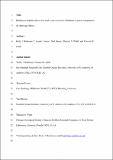Files in this item
Bottlenose dolphin calves have multi-year elevations of plasma oxytocin compared to all other age classes
Item metadata
| dc.contributor.author | Robinson, Kelly J. | |
| dc.contributor.author | Ternes, Kerstin | |
| dc.contributor.author | Hazon, Neil | |
| dc.contributor.author | Wells, Randall | |
| dc.contributor.author | Janik, Vincent M. | |
| dc.date.accessioned | 2020-11-13T00:38:36Z | |
| dc.date.available | 2020-11-13T00:38:36Z | |
| dc.date.issued | 2020-01-15 | |
| dc.identifier | 262037403 | |
| dc.identifier | 94ee4e77-6859-462a-bed9-6556133f9d4e | |
| dc.identifier | 85075219741 | |
| dc.identifier | 000510531400014 | |
| dc.identifier.citation | Robinson , K J , Ternes , K , Hazon , N , Wells , R & Janik , V M 2020 , ' Bottlenose dolphin calves have multi-year elevations of plasma oxytocin compared to all other age classes ' , General and Comparative Endocrinology , vol. 286 , 113323 . https://doi.org/10.1016/j.ygcen.2019.113323 | en |
| dc.identifier.issn | 0016-6480 | |
| dc.identifier.other | ORCID: /0000-0001-7894-0121/work/64698182 | |
| dc.identifier.other | ORCID: /0000-0002-6212-9710/work/75996843 | |
| dc.identifier.uri | https://hdl.handle.net/10023/20963 | |
| dc.description | Fieldwork for this study was funded by the Grossman Family Foundation, Dolphin Quest, Inc., NOAA Fisheries, Disney, the Office of Naval Research, the Batchelor Foundation, and the Joint Industry Program. The Marine Alliance for Science and Technology for Scotland (MASTS) funded the transport of all samples to the UK and all laboratory analysis. | en |
| dc.description.abstract | Providing for infants nutritionally via lactation is one of the hallmarks of mammalian reproduction, and infants without motivated mothers providing for them are unlikely to survive. Mothers must maintain regular contact with infants both spatially and temporally while utilising their environment to forage, avoid threats and find shelter. However, mothers can only do this and maximise their reproductive success with some degree of co-operation from infants, despite their developing physical and cognitive capabilities. The neuropeptide hormone oxytocin (OT) triggers proximity-seeking behaviour and acts in a positive feedback loop across mother-infant bonds, stimulating appropriate pro-social behaviour across the pair. However, data on infant OT levels is lacking, and it is unclear how important infants are in maintaining mother-infant associations. The bottlenose dolphin (Tursiops truncatus) is a mammalian species that is fully physically mobile at birth and has multi-year, but individually variable, lactation periods. We investigated OT concentrations in mother-infant pairs of wild individuals compared to other age and reproductive classes. An ELISA to detect OT in dolphin plasma was successfully validated with extracted plasma. We highlight a statistical method for testing for parallelism that could be applied to other ELISA validation studies. OT concentrations were consistently elevated in calves up to at least 4 years of age with lactating mothers (12.1 ±0.9 pg/ml), while all mothers (4.5 ±0.4 pg/ml) had OT concentrations comparable to non-lactating individuals (5.9 ±0.5 pg/ml). Concentrations within infants were individually variable, and may reflect the strength of the bond with their mother. The OT system likely provides a physiological mechanism for motivating infants to perform behaviours that prevent long-term separation from their mothers during this crucial time in their life history. Elevated infant OT has also been linked to energetic and developmental advantages which may lead to greater survival rates. Environmental or anthropogenic disturbances to OT release can occur during bond formation or can disrupt the communication methods used to reinforce these bonds via OT elevation. Variation in OT expression in infants, and its behavioural and physiological consequences, may explain differences in reproductive success despite appropriate maternal behaviour expression. | |
| dc.format.extent | 666463 | |
| dc.language.iso | eng | |
| dc.relation.ispartof | General and Comparative Endocrinology | en |
| dc.subject | Infant behaviour | en |
| dc.subject | Maternal behaviour | en |
| dc.subject | Mother-infant bonds | en |
| dc.subject | Oxytocin | en |
| dc.subject | Proximity seeking | en |
| dc.subject | Separation | en |
| dc.subject | QH301 Biology | en |
| dc.subject | NDAS | en |
| dc.subject.lcc | QH301 | en |
| dc.title | Bottlenose dolphin calves have multi-year elevations of plasma oxytocin compared to all other age classes | en |
| dc.type | Journal article | en |
| dc.contributor.institution | University of St Andrews. Marine Alliance for Science & Technology Scotland | en |
| dc.contributor.institution | University of St Andrews. Scottish Oceans Institute | en |
| dc.contributor.institution | University of St Andrews. School of Biology | en |
| dc.contributor.institution | University of St Andrews. Sea Mammal Research Unit | en |
| dc.contributor.institution | University of St Andrews. Institute of Behavioural and Neural Sciences | en |
| dc.contributor.institution | University of St Andrews. Centre for Social Learning & Cognitive Evolution | en |
| dc.contributor.institution | University of St Andrews. Bioacoustics group | en |
| dc.identifier.doi | https://doi.org/10.1016/j.ygcen.2019.113323 | |
| dc.description.status | Peer reviewed | en |
| dc.date.embargoedUntil | 2020-11-13 |
This item appears in the following Collection(s)
Items in the St Andrews Research Repository are protected by copyright, with all rights reserved, unless otherwise indicated.

